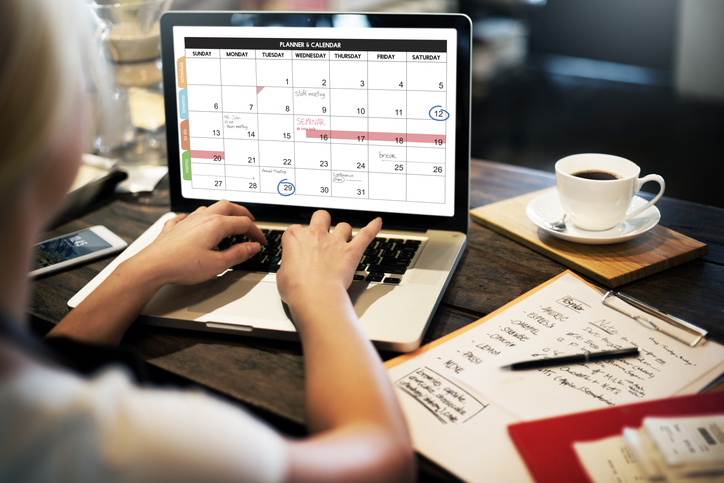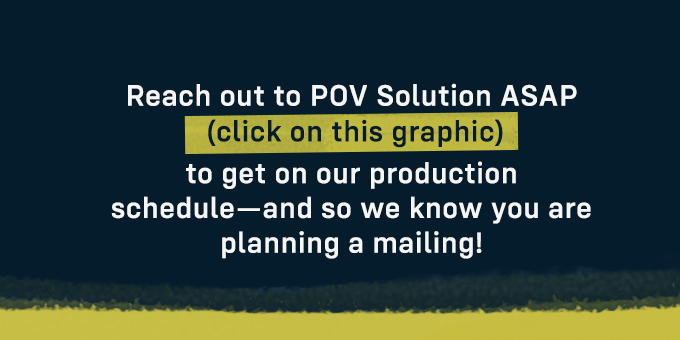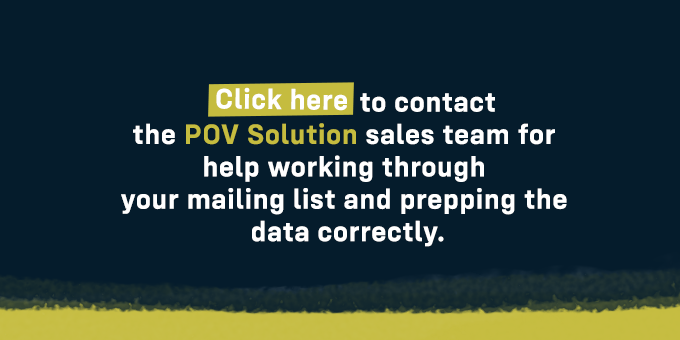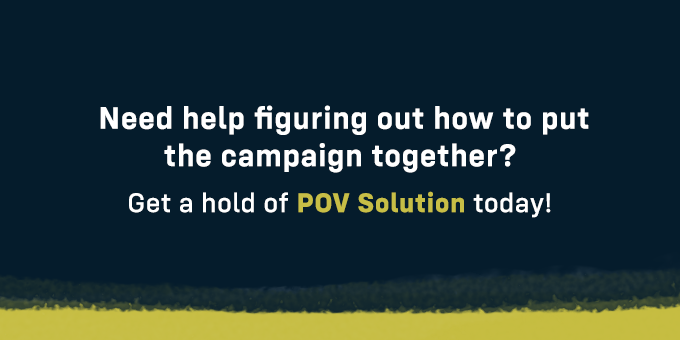
Conventional wisdom says to start planning seriously for your end-of-year fundraising in August—or even earlier! And there’s a reason for that: Anyone familiar with the process knows it takes a lot of coordinated time and effort.
“Our most successful clients,” writes Alyssa Conrardy, “start planning their year-end campaigns over the summer and begin working in earnest on campaign collateral no later than September 1st.” Conrardy is president and co-founder of Prosper Strategies, a Chicago-based nonprofit marketing agency.
But what if you’re way behind and want to make the best of a less-than-ideal timeline? Conrardy says if it’s already September or later, you’ll need to “ruthlessly prioritize” your tasks.
So how do you do that? Based on decades of experience helping nonprofits with their year-end donation appeals, POV Solution has compiled a down-and-dirty list of tips to help fast-track your process. To make that list even stronger, we’ve also included valuable insights from Conrardy.

1. Realize Just How Crucial Your End-of-Year Campaign Is
How important is your year-end push for generating donations? If you’re like most nonprofits, it’s downright critical. Consider these compelling stats reported by the fundraising firm Winspire:
- Almost 1/3 of nonprofit donations happen in December
- Half of nonprofits get the majority of their donations from October to December
- First-time donations made in December are 52% larger than those made at other times of the year
How’s that for some motivation? The point here is this: Don’t waste time thinking about what you should have done—you can do that after the campaign. It’s time to rally your team and get focused.

2. Start Today With Your Process
If you’re reading this in September and have yet to establish a solid plan for your year-end appeal, all is not lost. Begin reaching out immediately and alerting your key players, both your in-house staff and external support. Confirm that they can be ready to support your efforts:
- Graphic designer
- Copywriter
- Website support
- Print vendor
- The person in charge of the mailing list
- Executives, board members, and others who need to review and approve material (more on that below)
You also need to confirm your budget. That’s obviously going to play a role in what’s possible for your efforts.
3. Choose Your Tactics by Analyzing Last Year’s Results
Meanwhile, you need to decide on the tactics you’re going to use—direct mail, email, events, social media, etc.
Just how behind are you? As painful as it may be, this year may not be the time to try and get super-creative with themes and messaging, or tactics.
Pick one or two of your most compelling stories from the year to drive your theme. Then go with tried-and-true tactics by looking at the quantifiable data you hopefully already have. What worked really well last year? If you have some clear front-runners, you may want to just go with them and ditch the rest.
4. Look for Ways to Simplify and Fast-Track Tactics
If you want some ideas for fast-tracking your chosen tactics, consider these approaches:
For direct mail, you could opt for something less complex that doesn’t involve numerous pieces and time-consuming assembly, like a self-contained mailer.
How fruitful have your digital efforts been? Conrardy points out that if you’re super-rushed, “Digital campaigns are certainly much easier to execute on a shorter timeline than direct mail campaigns.”
On the other hand, a multi-channel approach is still possible. Conrardy says a “soft launch” in October works well to:
- Introduce your campaign theme and stories from the year
- Remind donors of the impact of last year’s contributions
- Start to tease what’s to come in November and December
One way to do this is to send out a teaser email blast in October. Meanwhile, begin updating your website with year-end campaign info, and then shoot to have mailings out the week before Thanksgiving or two weeks before Christmas.
Conrardy also suggests acquiring donor leads with Facebook ads starting around October.

5. Motivate and Make it Real With Deadlines
Expedited schedules still need hard deadlines. Start designating them now with the help of those in the know. Push them to give you a rushed but still realistic timeline. They’ll need to answer these questions:
- How long will it take to actually develop a given campaign component—from initial planning discussions all the way to final design?
- How much time do we need for the writing and design components?
- Who needs to review this for final approval? More specifically, where (and who) are the possible hang-ups in the process? (More on this point in #6.)
Next, distribute your milestones and deadlines so everyone understands the expectations.
For your direct mail pieces specifically, work backwards from the target date you want material to show up in people’s mail. Is your goal actually possible? Your print vendor will be able to tell you.
If you’re shooting for a November mailing, for example, your printer should really be producing and possibly even shipping in October. Do you think you can get a piece written, designed, and approved by then? If not, shoot for December. That will buy you a couple more weeks.

6. Look for Ways to Streamline Your Approval Process
Before diving headlong into your fast-tracked end-of-year appeal plan, Conrardy says consider how you can improve your approvals process to keep things moving as quickly as possible.
“In our experience, campaigns often fall behind because of collateral having to go through multiple layers of review and approval,” says Conrardy. “Though there’s value in getting feedback from a variety of different stakeholders, try to streamline this process so you can prevent a never-ending cycle of revisions.”
7. Don’t Just Assume Your Mailing List is Ready
You may be in a race to get your materials ready, but you should still take the time to make your mailing list itself as good as it can be.
How long has it been since the list was updated? Who didn’t respond at all last year? Is it still worth the investment to include them? You could actually be wasting a lot of money on print orders that are too big.
Or, you may want to expand your ask and/or retarget your list. Mailing lists specialists can formulate targeted contacts by using some surprisingly specific parameters.
8. Segment Your Mailing List
Even if you’re behind the eight ball with your end-of-year donation appeal and need to cut some corners, you should still avoid doing a blanket approach with your touches. In other words, your direct mailings (and emails for that matter) should to some degree be segmented and personalized.
Who gave last year? Consider sending those donors an appeal that includes a message acknowledging their prior giving and reflects your appreciation.
How much did they give? For high-dollar donors, you may want to invest the time and money to create a personalized appeal that details how their donation was used and includes a message directly from someone at your nonprofit. But be warned: That takes time, so get on it now.

9. Avoid These Basic Mistakes
In the frenzy of a year-end campaign, even the most organized efforts can include some mistakes. According to Conrardy, here are three of the most common:
1. Forgetting to ask directly. Don’t leave your donor guessing what you want them to do, says Conrardy. Whether it’s in your mailers, emails, web pages or social media, make the donation ask crystal-clear with bold text, check boxes, buttons, and links.
2. Failing to align your direct mail and digital imagery. For example, explains Conrardy, “The header image on your donation page should be switched out to match the header on your most recent direct mail drop.”
3. Writing copy that is organization-centric rather than donor-centric. Emphasize and illustrate how donors are crucial to your organization and its mission.
10. Remember to say Thank You!
Take the time to build thank you’s into your process. At a bare minimum, that can be an automated thank you email. But you should try to personalize your communications if at all possible.
And it doesn’t have to be just one thank you. You may want to consider a follow-up post card that shows your appreciation and serves to strengthen your relationship for the coming year.

11. Make the Most of Your Results . . . for Next Year
Remember that when your end-of-year campaign is finished this year, you now have a chance to do better next year. That’s more than a nice thought—it’s a smart strategy. “Each year should absolutely be treated as a learning opportunity for the next,” says Conrardy.
She suggests tracking everything you can from your campaign. And once it’s over, “hold a post-mortem where you analyze all the data you’ve tracked,” says Conrardy. “Pull out 5-10 key takeaways and decide how they will inform the way you approach next year’s campaign.”
One likely takeaway? Start planning earlier next year.
For more information on end-of-year fundraising success, check out Conrardy’s blog post on the topic.
Are you interested in getting printing support with your end-of-year donation appeals? Would you like to elevate the quality of that mailing list—and maybe your overall distribution process? Contact POV Solution today to start a discussion.




